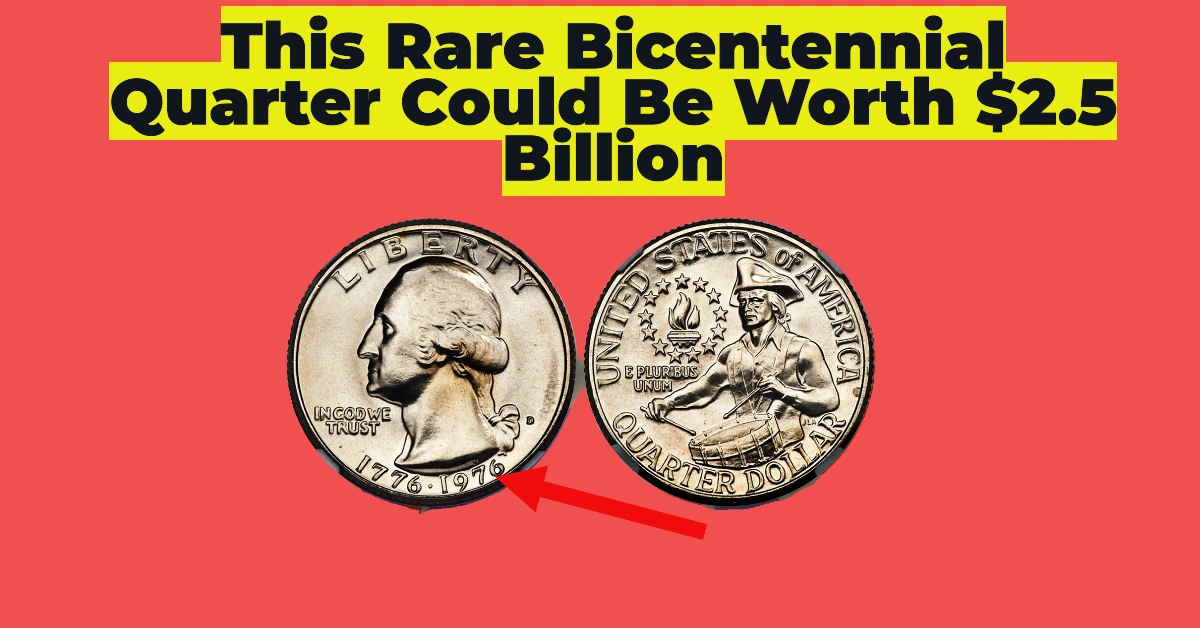Ever looked at a quarter and wondered, “Could this actually be worth a fortune?” It may sound like a far-fetched dream, but some quarters—especially the 1976 Bicentennial Quarter—have sparked wild rumors of astronomical value, with one specific coin allegedly worth a staggering $2.5 billion.
Table of Contents
Let’s separate fact from fiction, explore what makes certain Bicentennial quarters valuable, and show you exactly what to look for in your pocket change.
A Quarter Minted for America’s 200th Birthday
In celebration of the United States Bicentennial in 1976, the U.S. Mint released special editions of the quarter, half dollar, and dollar coins. The standard eagle on the back of the quarter was replaced with an eye-catching design: a Revolutionary War drummer, a torch of victory, and 13 stars representing the original colonies.
These quarters are marked 1776–1976 on the obverse and are still common in circulation today.
What You Might Find:
- Millions of these were struck using standard copper-nickel clad.
- A smaller batch (the 40% silver versions) was created for collector sets—these are the ones that hold real value.
Lincoln Wheat Penny Worth $305,000 Still Circulating: How to Identify One in Your Change
The 9 Rarest Mercury Dimes Worth $250 Million Each: History, Rarity & Market Value
Rare 1968 Kennedy Half Dollars – Discover What Makes These Coins Worth Big Money
10 Rare Pennies Worth $80 Million Circulating in the Market – Are You Holding a Fortune?
Is There Really a Bicentennial Quarter Worth $2.5 Billion?
Let’s get one thing straight: no Bicentennial Quarter has ever sold for $2.5 billion. That number is likely born of online myths, speculative hype, or extreme fictional valuation for a one-of-a-kind coin. But in theory, if a coin had all of the following characteristics, it could approach an astronomical value:
- Minted in gold or platinum in error (never officially issued)
- A flawless strike in perfect mint condition
- Unique historical provenance
- Confirmed one-of-a-kind status
While no such quarter has appeared at auction, this legend fuels ongoing excitement among collectors.
What Actually Makes a Bicentennial Quarter Valuable?
Though most Bicentennial Quarters are worth 25 cents, certain features can boost their value significantly:
1. 40% Silver Composition
- Found in collector sets (proof or uncirculated)
- Weighs slightly more (~5.75g vs. 5.67g standard)
- Value: $5–$20+, depending on condition
2. Double Die Errors
- Look for doubling in the text like “LIBERTY” or “IN GOD WE TRUST”
- These can sell for hundreds to thousands of dollars
3. Off-Center Strikes
- The coin looks misaligned, or part of the design is cut off
- These minting errors can be worth $50–$250+
4. Missing Clad Layer
- Appears coppery-red, dull, or lighter in weight
- Value depends on severity of the error: $100+
How to Tell If You Have a Rare Bicentennial Quarter
Here’s your quick visual and weight-based checklist:
- Date Check – Look for “1776–1976” on the front
- Reverse Design – Look for the drummer boy and torch
- Mint Mark – “S” (San Francisco) = possible silver collector coin
- Weigh It – Silver = approx. 5.75g; standard = 5.67g
- Use a Magnet – Shouldn’t stick; fake materials might
- Inspect Closely – Use a magnifying glass to spot doubling or off-center printing
Are Bicentennial Quarters Still in Circulation?
Yes! You can still find these quarters in:
- Loose change
- Coin rolls from banks
- Old family coin jars
- Garage sales or flea markets
Though most are standard issue, silver or error versions are still out there—and potentially very valuable.
Should You Be Checking Your Change?
Absolutely. While the chances of stumbling across a $2.5 billion coin are practically zero, finding a $100 or $1,000 quarter is entirely possible.
Coin collecting is more than a hobby—it’s a mix of history, mystery, and modern-day treasure hunting. Even if you don’t strike it rich, you’ll gain a new appreciation for the hidden gems in your everyday pocket change.
